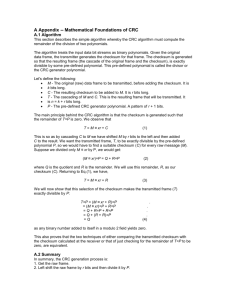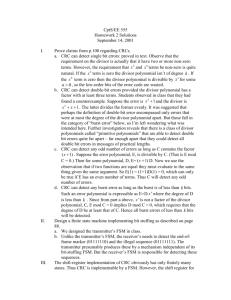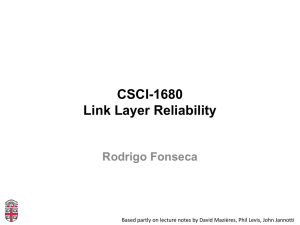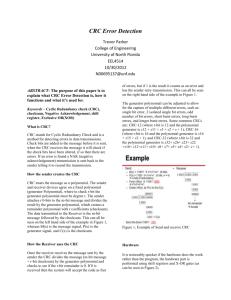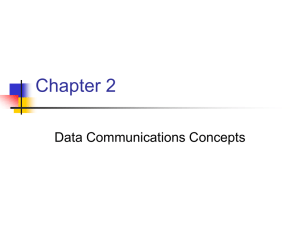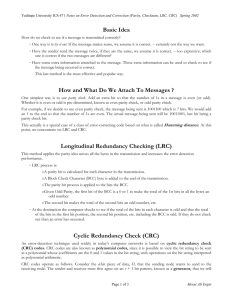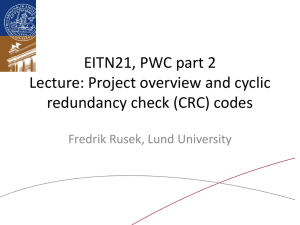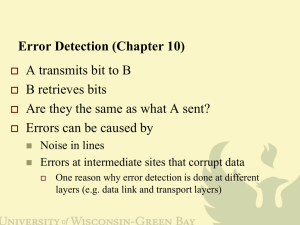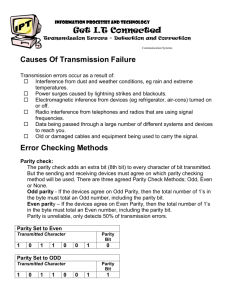Chapter 8 -- Reliability - California State University, Long Beach
advertisement
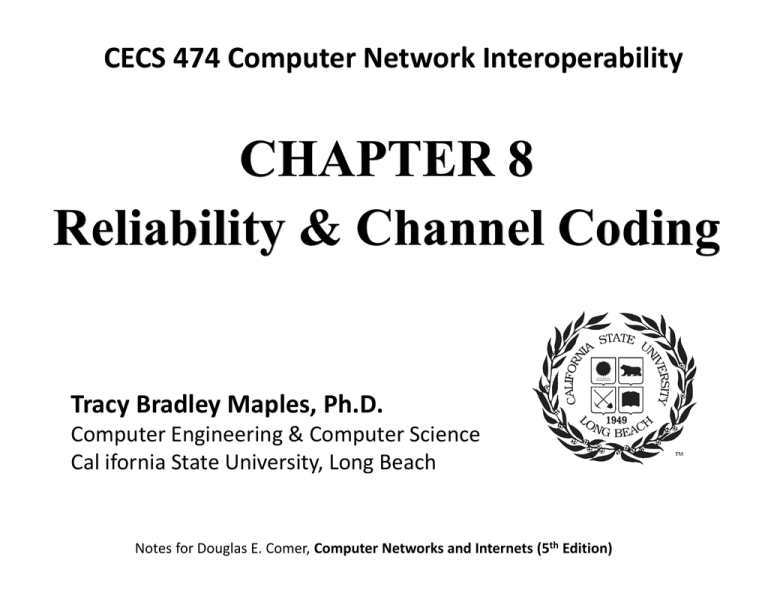
CECS 474 Computer Network Interoperability CHAPTER 8 Reliability & Channel Coding Tracy Bradley Maples, Ph.D. Computer Engineering & Computer Science Cal ifornia State University, Long Beach Notes for Douglas E. Comer, Computer Networks and Internets (5th Edition) Errors Problem: All data communications systems are susceptible to errors • The physics of the universe causes errors. • Devices fail and/or equipment does not meet engineering standards. Thus: We need ways/mechanisms to control and recover from errors. Note: Small errors are often more difficult to detect than complete failures. Three Main Sources of Transmission Errors 1. Interference Example: Electromagnetic radiation interferes with electrical signals 2. Distortion Rule: All physical systems distort signals 3. Attenuation Example: As a signal passes across a medium, the signal becomes weaker Reducing Errors Shannon's Theorem suggests one way to reduce errors: Increase the signal-to-noise ratio (either by increasing the signal or lowering noise if possible) Unfortunately, it is not always possible to change the signal-to-noise ratio. Example: Mechanisms like shielded wiring can help lower noise but a physical transmission system is always susceptible to some noise Bottom Line: Noise/interference cannot be eliminated completely Fortunately, many transmission errors can be detected. In some cases, errors can even be corrected automatically (but hardly ever!) Conclusion: Error handling is a tradeoff between the need for detecting errors and the additional overhead for error detection and/or correction. Effect of Transmission Errors on Data Two key Characteristics of errors: 1. BER bit error rate: Probability P of a single bit being corrupted in a defined time interval. 2. Random (or burst) errors: Whether the errors occur as random single-bit errors or as groups of contiguous errors. Error Detection and Correction A variety of mathematical techniques have been developed that overcome errors during transmission and increase reliability. These techniques are known collectively as channel coding. Two primary approaches: 1. Error Control • Forward Error Control (FEC) mechanisms • Backward Error Control (BEC) mechanisms 2. Automatic Repeat reQuest (ARQ) mechanisms Error Control (FEC & BEC) Basic idea of Error Control: Add additional information to the data that allows a receiver to verify that data arrives correctly and to correct errors (if possible). Backward error control (error detecting): Each transmitted character or frame contains additional information so that the receivers can detect but not correct errors. A retransmission scheme must also be used. Forward error control (error correcting): Each transmitted character or frame contains additional information so that the receivers can detect and correct errors. Parity Simplest method for detecting bit errors: Single Parity Checking (SPC) Add the # of 1 bits in the code together (modulo 2) and choose the parity bit so that the total number of one bits is: • even (even parity) or • odd (odd parity) A parity bit can be used to detect 1-bit errors in the code. SPC is a weak form of channel coding that can detect errors but cannot correct errors. An single-bit parity mechanism can only handle errors where an odd number of bits are changed Two-Dimensional Parity (Block sum check) • Used with blocks of characters • Use a row parity bit for each byte • Use a column parity for each bit column position in the complete frame Internet Checksum Algorithm The Internet checksum is a simple error detection technique used by TCP/IP. The Internet Checksum Algorithm is simple: • treat the data being transmitted as 16-bit integers, • add them together using 16-bit ones-complement arithmetic, • take the complement of the sum as the checksum, • send the checksum across the network with the original data. The Internet checksum: • Does not have strong error detection properties, but handles many multiple bit errors • Cannot handle all errors • It is easy to implement in software • It is used in a end-to-end manner, so lower layer protocols catch most of the errors Example: Internet Checksum Computation The checksum is computed over the data: The checksum is then appended to the frame. Example: An Error Checksum Fails To Detect When the second bit is reversed in each item, the two Checksums are the same. Internet Checksum Algorithm (Cont’d) The Internet checksum: • does not have strong error detection properties, but handles many multiple bit errors • Cannot handle all errors • is easy to implement in software • is used in a end-to-end manner, so lower layer protocols catch most of the errors Cyclic Redundancy Code (CRC) A form of channel coding known as a Cyclic Redundancy Code (CRC) is used in high-speed data networks Key properties of CRC are summarized below: CRC (cont’d) Cyclic redundancy codes: • Uses a mathematical function • More complex to compute than checksums • Handles more errors • Used with frame transmission schemes • A single set of check digits is generated and appended at the end of each frame transmitted • In this method the bits of data are treated as coefficients of a polynomial CRC (cont’d) CRC Coding: A k-bit message is regarded as the coefficient list for a polynomial with k terms, ranging from x(k-1) to x0. The high-order (leftmost) bit is the coefficient of x(k-1); the next bit is the coefficient of x(k-2), and so on. The check digits are generated by multiplying the k-bit message by xn and dividing the product by an (n+1)-bit code polynomial (modulo 2). The n-bit remainder is used as the check digits. Decoding: The complete received bit sequence is divided by the same generator polynomial (modulo 2). If the remainder is zero, no errors occurred. If the remainder is nonzero, a transmission error has occurred. CRC Calculation This figure shows the division of 1010 (k=4) which represents the data by a constant generator function: 1011 (n+1=4). Figure 8.12 CRC (cont’d) A generator polynomial of N+1 bits will detect: • all single-bit errors • all double-bit errors • all odd-number of bit errors • all error bursts < N+1 bits • most error bursts >= N+1 bits CRCs and Polynomial Representation We can view the above process as a polynomial division: Think of each bit in a binary number as the coefficient of a term in a polynomial For example, we can think of the divisor in Figure 8.12, 1011, as coefficients in the following polynomial: Similarly, the dividend in Figure 8.12, 1010000, represents the polynomial: Code Polynomials (or generator polynomials): Code polynomials are usually of degree 12 or 16 or 32 Six polynomials are in widespread use: • • • • Ethernet and FDDI use CRC-32 HDLC uses CRC-CCITT ATM uses CRC-8 and CRC-10 Three polynomials are international standards: CRC-12, CRC-16, and CRCCCITT Building Blocks For Implementing CRC Exclusive OR Shift register • a shows status before shift • b shows status after shift • Output same as top bit Example Of CRC Hardware Computes 16-bit CRC Registers initialized to zero Bits of message shifted in CRC found in registers Illustration of Frame Using CRC Note: The CRC covers data only Automatic Repeat reQuest (ARQ) Mechanisms Whenever one side sends a message to another, the other side sends a short acknowledgement (ACK) message back For example: • If A sends a message to B, B sends an ACK back to A • Once A receives the ACK, it knows that the message arrived correctly • If no ACK is received after T time units, A assumes the message was lost and retransmits a copy ARQ is especially useful when errors are detected. ARQ cannot handle error correction Error Detection Schemes in the Internet Most Layer 2 Protocols (e.g., Ethernet, Wi-Fi) Use CRC to detect transmission errors TCP (Transmission Control Protocol) Uses an ARQ scheme is added to guarantee delivery. If a transmission error occurs: 1. The receiver discards the message with an error 1. The sender retransmits another copy More on TCP (and Reliable Data Transmission later)…
